Innovation and Technology: The Deep Aquarium's Online Learning Report
VerifiedAdded on 2023/06/04
|13
|3166
|202
Report
AI Summary
This report provides a critical analysis of the challenges and opportunities within the online/e-learning environment of The Deep Aquarium, a public aquarium in the UK. It begins with an introduction and a table of contents, followed by a comprehensive PESTEL analysis to evaluate the external environment, identifying political, economic, sociological, technological, environmental, and legal factors. The report then examines the challenges and opportunities in online learning, including technological limitations, socio-economic disparities, and the potential for research and technological innovations. Furthermore, it evaluates future technologies relevant to the project, such as virtual reality, augmented reality, and artificial intelligence, and explains how these technologies can be used to enhance the learning experience. Finally, the report identifies and explains the steps needed to provide a market-oriented solution, emphasizing the importance of gathering market research intelligence. The report concludes by summarizing the key findings and recommendations for The Deep Aquarium to improve its online learning platform.
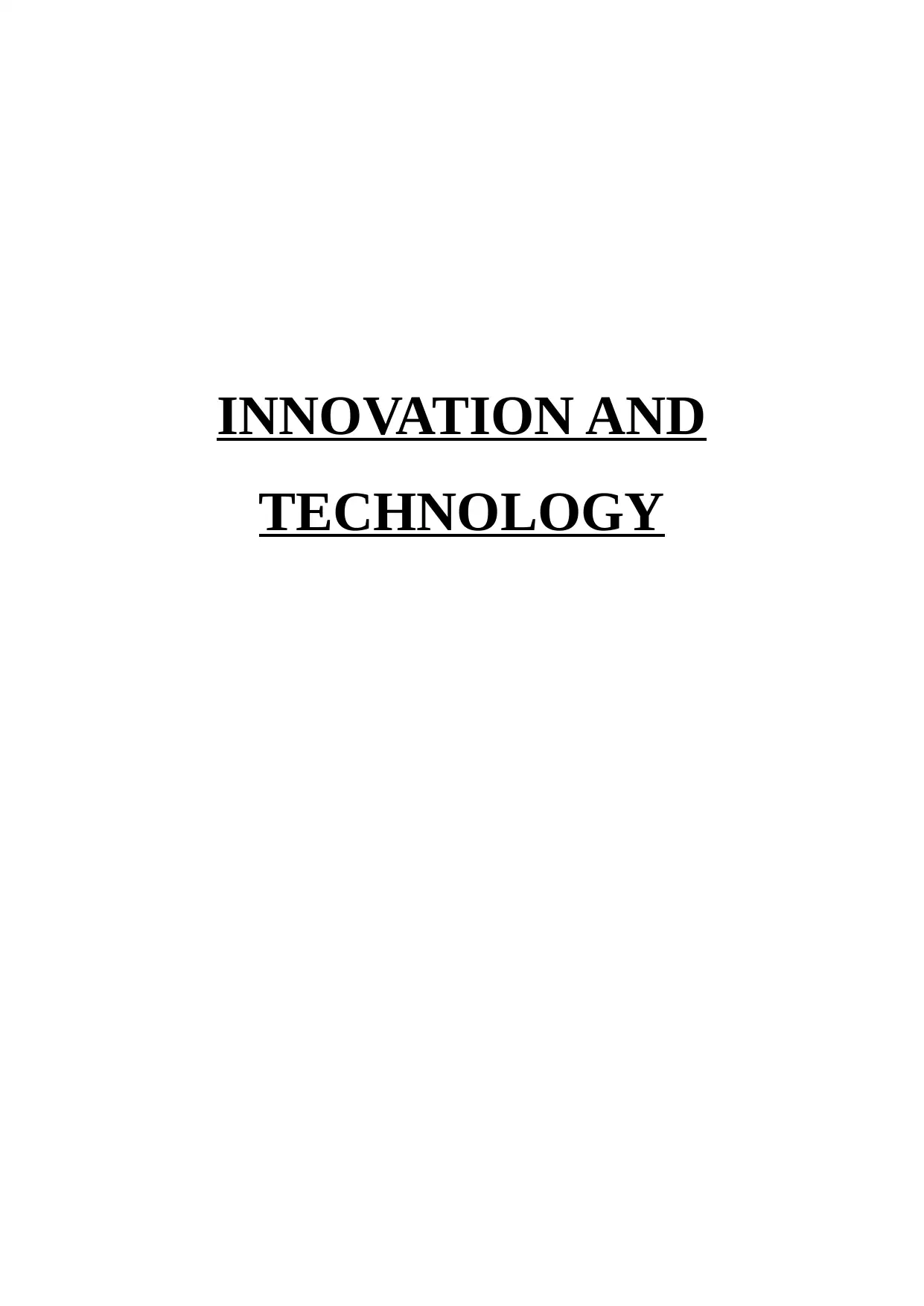
INNOVATION AND
TECHNOLOGY
TECHNOLOGY
Paraphrase This Document
Need a fresh take? Get an instant paraphrase of this document with our AI Paraphraser
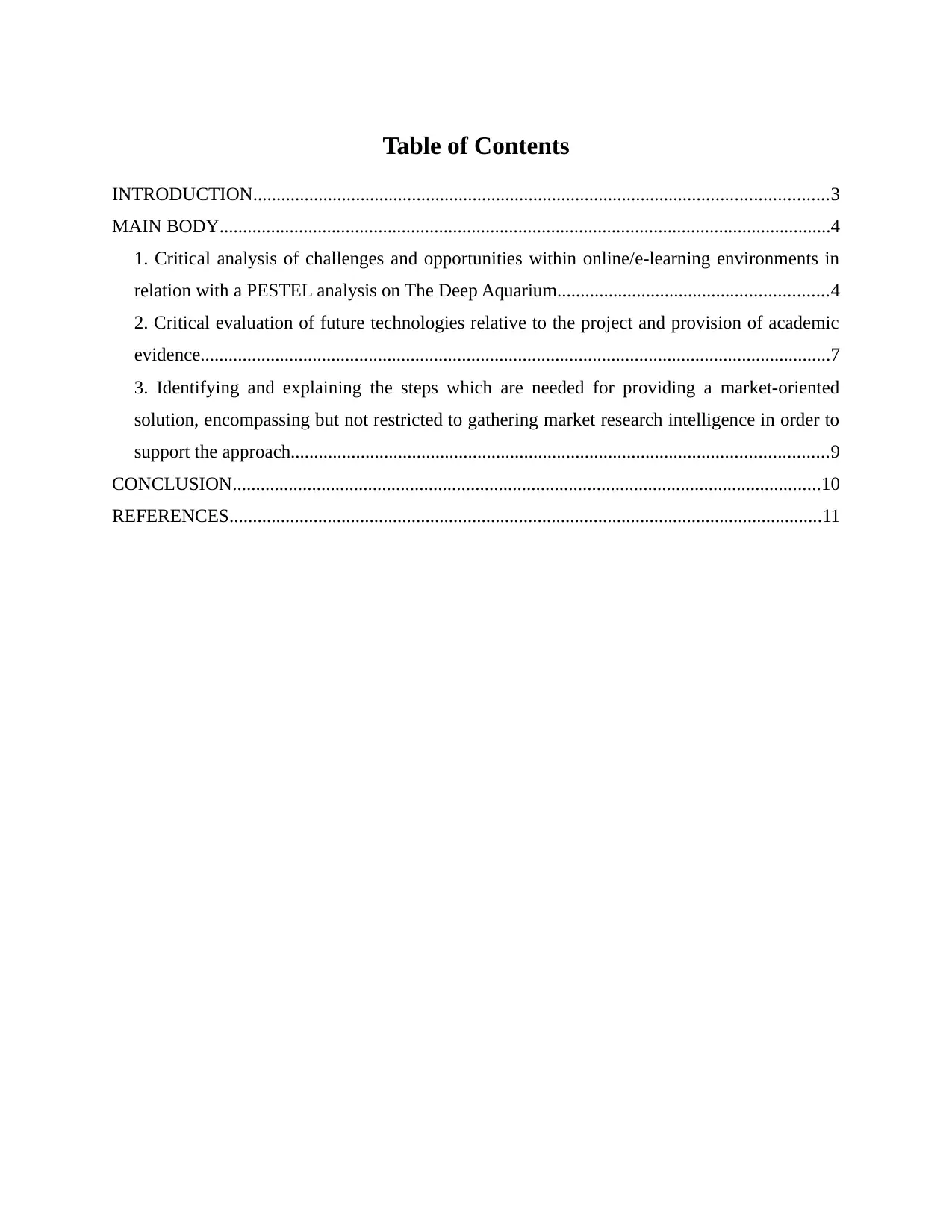
Table of Contents
INTRODUCTION...........................................................................................................................3
MAIN BODY...................................................................................................................................4
1. Critical analysis of challenges and opportunities within online/e-learning environments in
relation with a PESTEL analysis on The Deep Aquarium..........................................................4
2. Critical evaluation of future technologies relative to the project and provision of academic
evidence.......................................................................................................................................7
3. Identifying and explaining the steps which are needed for providing a market-oriented
solution, encompassing but not restricted to gathering market research intelligence in order to
support the approach...................................................................................................................9
CONCLUSION..............................................................................................................................10
REFERENCES...............................................................................................................................11
INTRODUCTION...........................................................................................................................3
MAIN BODY...................................................................................................................................4
1. Critical analysis of challenges and opportunities within online/e-learning environments in
relation with a PESTEL analysis on The Deep Aquarium..........................................................4
2. Critical evaluation of future technologies relative to the project and provision of academic
evidence.......................................................................................................................................7
3. Identifying and explaining the steps which are needed for providing a market-oriented
solution, encompassing but not restricted to gathering market research intelligence in order to
support the approach...................................................................................................................9
CONCLUSION..............................................................................................................................10
REFERENCES...............................................................................................................................11
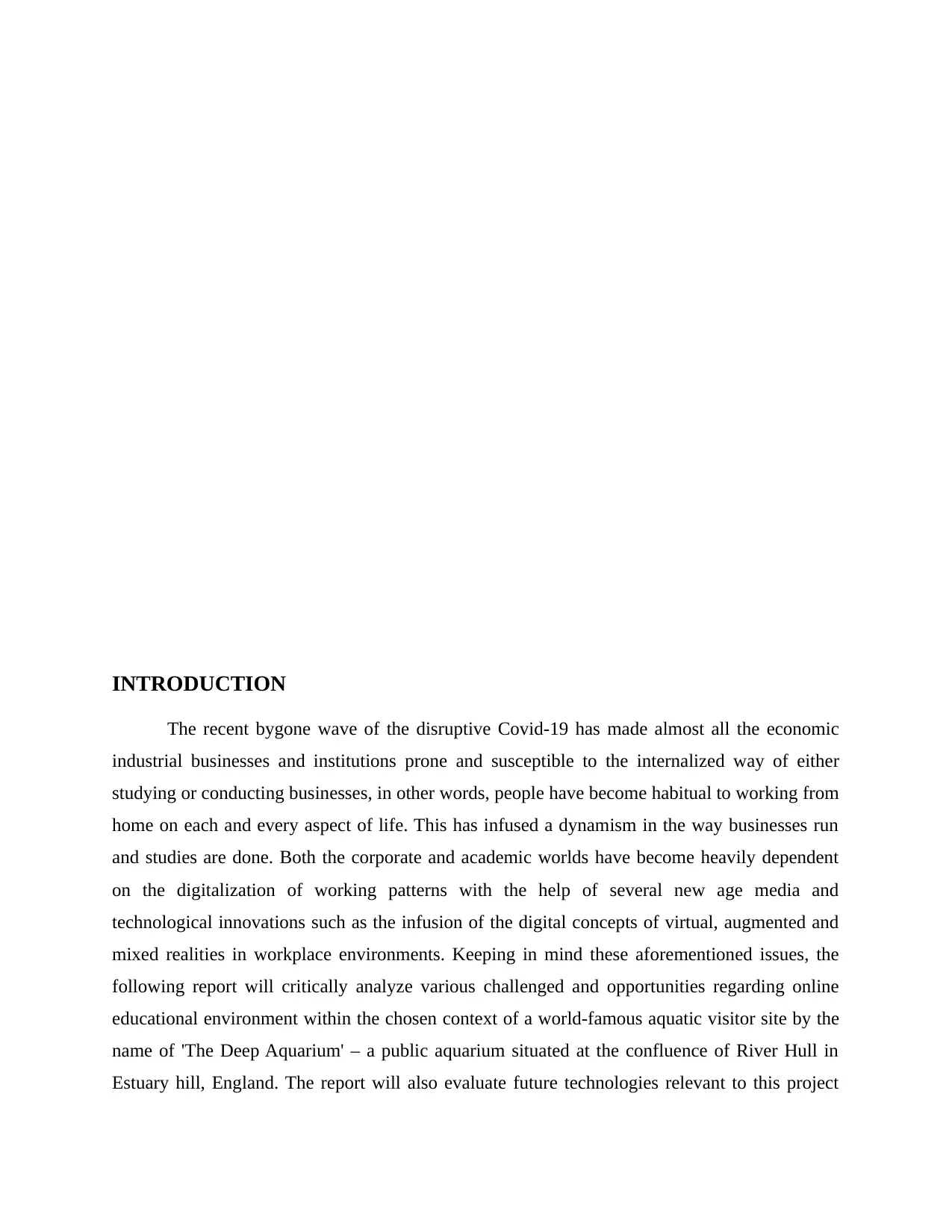
INTRODUCTION
The recent bygone wave of the disruptive Covid-19 has made almost all the economic
industrial businesses and institutions prone and susceptible to the internalized way of either
studying or conducting businesses, in other words, people have become habitual to working from
home on each and every aspect of life. This has infused a dynamism in the way businesses run
and studies are done. Both the corporate and academic worlds have become heavily dependent
on the digitalization of working patterns with the help of several new age media and
technological innovations such as the infusion of the digital concepts of virtual, augmented and
mixed realities in workplace environments. Keeping in mind these aforementioned issues, the
following report will critically analyze various challenged and opportunities regarding online
educational environment within the chosen context of a world-famous aquatic visitor site by the
name of 'The Deep Aquarium' – a public aquarium situated at the confluence of River Hull in
Estuary hill, England. The report will also evaluate future technologies relevant to this project
The recent bygone wave of the disruptive Covid-19 has made almost all the economic
industrial businesses and institutions prone and susceptible to the internalized way of either
studying or conducting businesses, in other words, people have become habitual to working from
home on each and every aspect of life. This has infused a dynamism in the way businesses run
and studies are done. Both the corporate and academic worlds have become heavily dependent
on the digitalization of working patterns with the help of several new age media and
technological innovations such as the infusion of the digital concepts of virtual, augmented and
mixed realities in workplace environments. Keeping in mind these aforementioned issues, the
following report will critically analyze various challenged and opportunities regarding online
educational environment within the chosen context of a world-famous aquatic visitor site by the
name of 'The Deep Aquarium' – a public aquarium situated at the confluence of River Hull in
Estuary hill, England. The report will also evaluate future technologies relevant to this project
⊘ This is a preview!⊘
Do you want full access?
Subscribe today to unlock all pages.

Trusted by 1+ million students worldwide
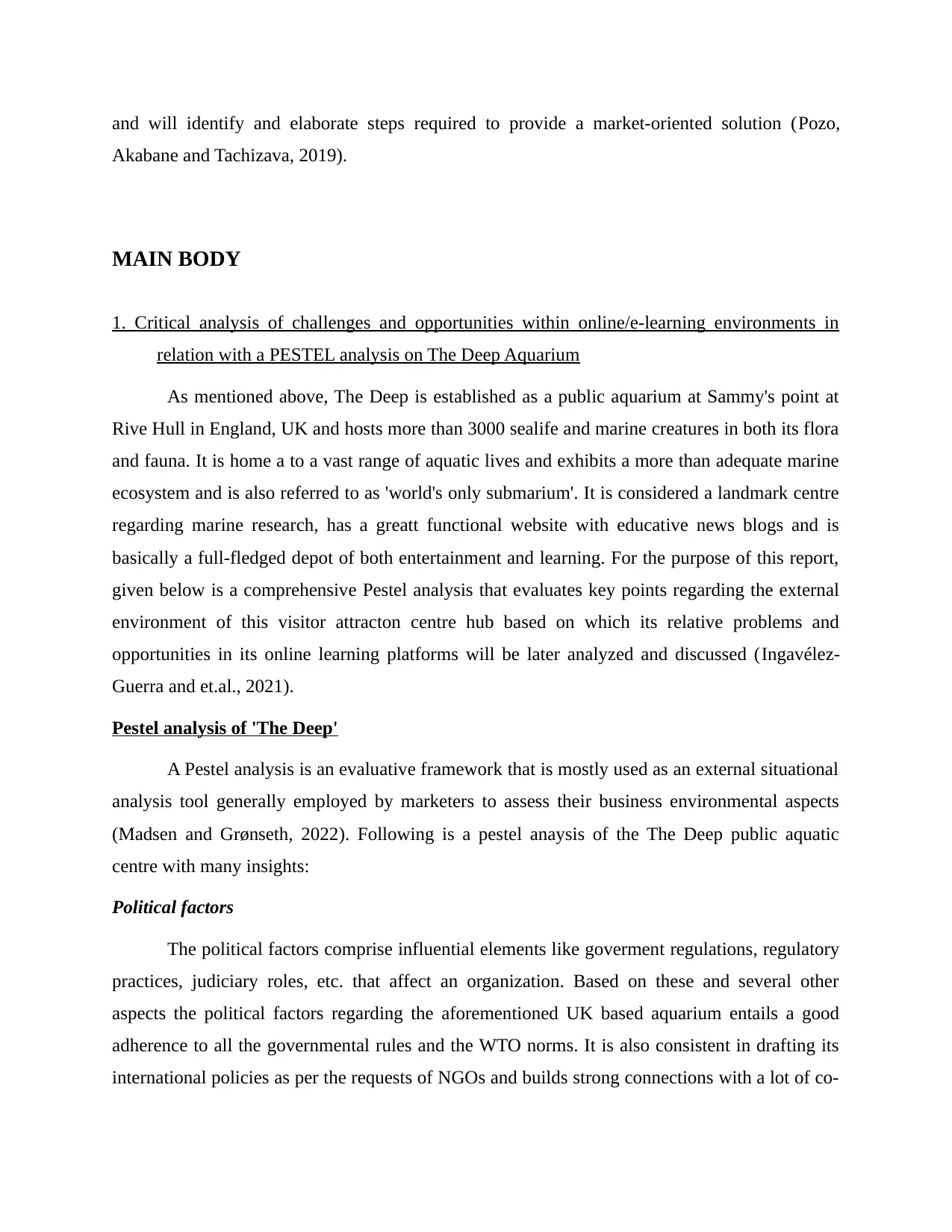
and will identify and elaborate steps required to provide a market-oriented solution (Pozo,
Akabane and Tachizava, 2019).
MAIN BODY
1. Critical analysis of challenges and opportunities within online/e-learning environments in
relation with a PESTEL analysis on The Deep Aquarium
As mentioned above, The Deep is established as a public aquarium at Sammy's point at
Rive Hull in England, UK and hosts more than 3000 sealife and marine creatures in both its flora
and fauna. It is home a to a vast range of aquatic lives and exhibits a more than adequate marine
ecosystem and is also referred to as 'world's only submarium'. It is considered a landmark centre
regarding marine research, has a greatt functional website with educative news blogs and is
basically a full-fledged depot of both entertainment and learning. For the purpose of this report,
given below is a comprehensive Pestel analysis that evaluates key points regarding the external
environment of this visitor attracton centre hub based on which its relative problems and
opportunities in its online learning platforms will be later analyzed and discussed (Ingavélez-
Guerra and et.al., 2021).
Pestel analysis of 'The Deep'
A Pestel analysis is an evaluative framework that is mostly used as an external situational
analysis tool generally employed by marketers to assess their business environmental aspects
(Madsen and Grønseth, 2022). Following is a pestel anaysis of the The Deep public aquatic
centre with many insights:
Political factors
The political factors comprise influential elements like goverment regulations, regulatory
practices, judiciary roles, etc. that affect an organization. Based on these and several other
aspects the political factors regarding the aforementioned UK based aquarium entails a good
adherence to all the governmental rules and the WTO norms. It is also consistent in drafting its
international policies as per the requests of NGOs and builds strong connections with a lot of co-
Akabane and Tachizava, 2019).
MAIN BODY
1. Critical analysis of challenges and opportunities within online/e-learning environments in
relation with a PESTEL analysis on The Deep Aquarium
As mentioned above, The Deep is established as a public aquarium at Sammy's point at
Rive Hull in England, UK and hosts more than 3000 sealife and marine creatures in both its flora
and fauna. It is home a to a vast range of aquatic lives and exhibits a more than adequate marine
ecosystem and is also referred to as 'world's only submarium'. It is considered a landmark centre
regarding marine research, has a greatt functional website with educative news blogs and is
basically a full-fledged depot of both entertainment and learning. For the purpose of this report,
given below is a comprehensive Pestel analysis that evaluates key points regarding the external
environment of this visitor attracton centre hub based on which its relative problems and
opportunities in its online learning platforms will be later analyzed and discussed (Ingavélez-
Guerra and et.al., 2021).
Pestel analysis of 'The Deep'
A Pestel analysis is an evaluative framework that is mostly used as an external situational
analysis tool generally employed by marketers to assess their business environmental aspects
(Madsen and Grønseth, 2022). Following is a pestel anaysis of the The Deep public aquatic
centre with many insights:
Political factors
The political factors comprise influential elements like goverment regulations, regulatory
practices, judiciary roles, etc. that affect an organization. Based on these and several other
aspects the political factors regarding the aforementioned UK based aquarium entails a good
adherence to all the governmental rules and the WTO norms. It is also consistent in drafting its
international policies as per the requests of NGOs and builds strong connections with a lot of co-
Paraphrase This Document
Need a fresh take? Get an instant paraphrase of this document with our AI Paraphraser
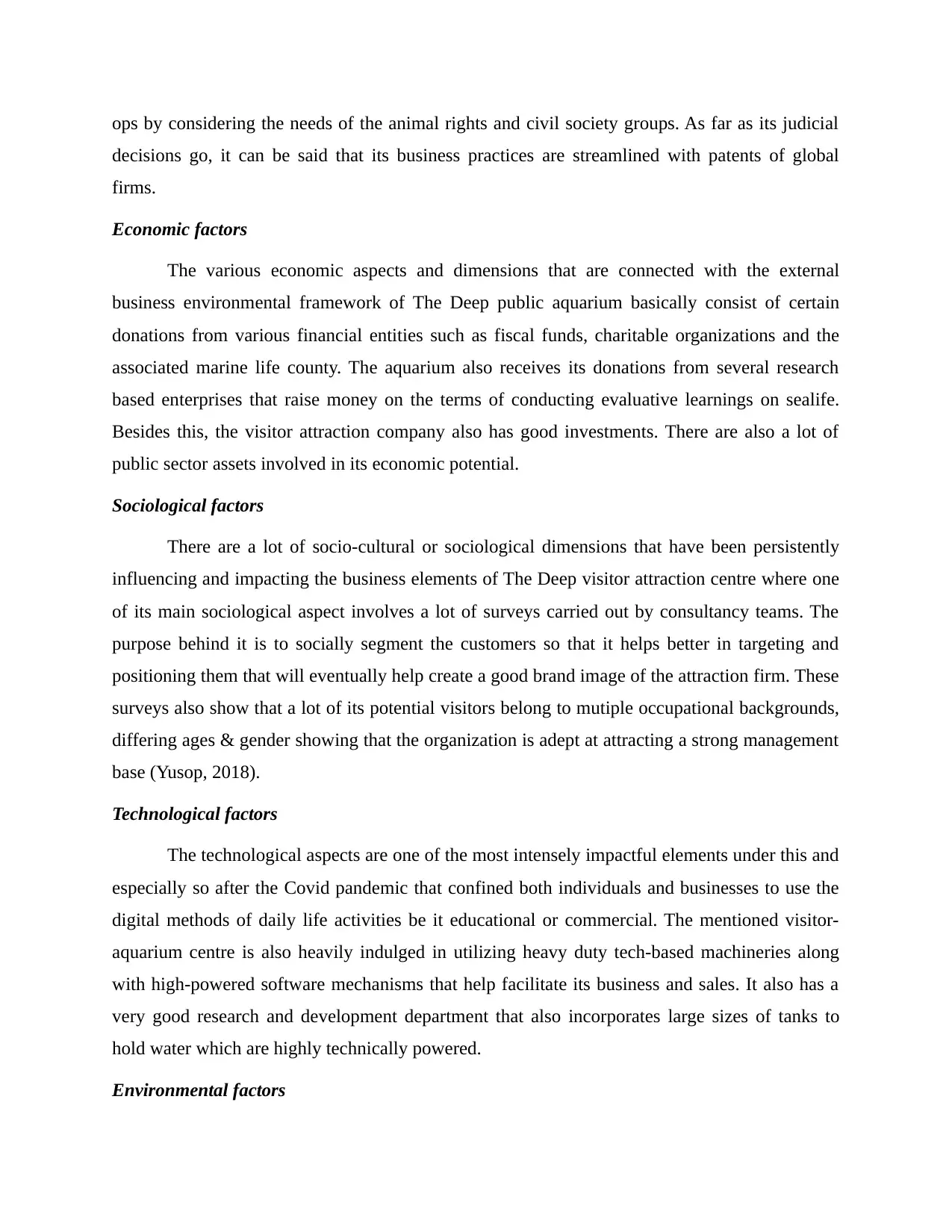
ops by considering the needs of the animal rights and civil society groups. As far as its judicial
decisions go, it can be said that its business practices are streamlined with patents of global
firms.
Economic factors
The various economic aspects and dimensions that are connected with the external
business environmental framework of The Deep public aquarium basically consist of certain
donations from various financial entities such as fiscal funds, charitable organizations and the
associated marine life county. The aquarium also receives its donations from several research
based enterprises that raise money on the terms of conducting evaluative learnings on sealife.
Besides this, the visitor attraction company also has good investments. There are also a lot of
public sector assets involved in its economic potential.
Sociological factors
There are a lot of socio-cultural or sociological dimensions that have been persistently
influencing and impacting the business elements of The Deep visitor attraction centre where one
of its main sociological aspect involves a lot of surveys carried out by consultancy teams. The
purpose behind it is to socially segment the customers so that it helps better in targeting and
positioning them that will eventually help create a good brand image of the attraction firm. These
surveys also show that a lot of its potential visitors belong to mutiple occupational backgrounds,
differing ages & gender showing that the organization is adept at attracting a strong management
base (Yusop, 2018).
Technological factors
The technological aspects are one of the most intensely impactful elements under this and
especially so after the Covid pandemic that confined both individuals and businesses to use the
digital methods of daily life activities be it educational or commercial. The mentioned visitor-
aquarium centre is also heavily indulged in utilizing heavy duty tech-based machineries along
with high-powered software mechanisms that help facilitate its business and sales. It also has a
very good research and development department that also incorporates large sizes of tanks to
hold water which are highly technically powered.
Environmental factors
decisions go, it can be said that its business practices are streamlined with patents of global
firms.
Economic factors
The various economic aspects and dimensions that are connected with the external
business environmental framework of The Deep public aquarium basically consist of certain
donations from various financial entities such as fiscal funds, charitable organizations and the
associated marine life county. The aquarium also receives its donations from several research
based enterprises that raise money on the terms of conducting evaluative learnings on sealife.
Besides this, the visitor attraction company also has good investments. There are also a lot of
public sector assets involved in its economic potential.
Sociological factors
There are a lot of socio-cultural or sociological dimensions that have been persistently
influencing and impacting the business elements of The Deep visitor attraction centre where one
of its main sociological aspect involves a lot of surveys carried out by consultancy teams. The
purpose behind it is to socially segment the customers so that it helps better in targeting and
positioning them that will eventually help create a good brand image of the attraction firm. These
surveys also show that a lot of its potential visitors belong to mutiple occupational backgrounds,
differing ages & gender showing that the organization is adept at attracting a strong management
base (Yusop, 2018).
Technological factors
The technological aspects are one of the most intensely impactful elements under this and
especially so after the Covid pandemic that confined both individuals and businesses to use the
digital methods of daily life activities be it educational or commercial. The mentioned visitor-
aquarium centre is also heavily indulged in utilizing heavy duty tech-based machineries along
with high-powered software mechanisms that help facilitate its business and sales. It also has a
very good research and development department that also incorporates large sizes of tanks to
hold water which are highly technically powered.
Environmental factors
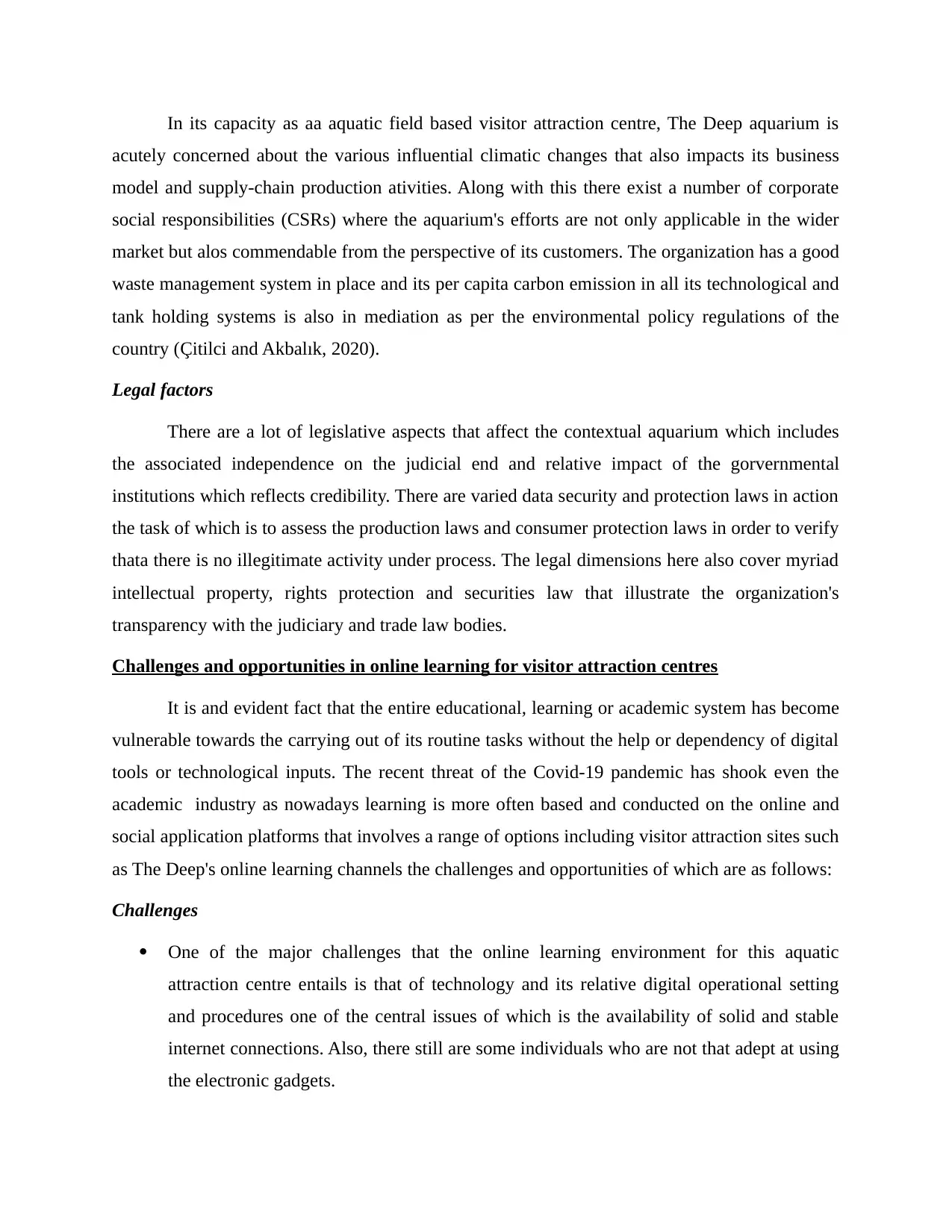
In its capacity as aa aquatic field based visitor attraction centre, The Deep aquarium is
acutely concerned about the various influential climatic changes that also impacts its business
model and supply-chain production ativities. Along with this there exist a number of corporate
social responsibilities (CSRs) where the aquarium's efforts are not only applicable in the wider
market but alos commendable from the perspective of its customers. The organization has a good
waste management system in place and its per capita carbon emission in all its technological and
tank holding systems is also in mediation as per the environmental policy regulations of the
country (Çitilci and Akbalık, 2020).
Legal factors
There are a lot of legislative aspects that affect the contextual aquarium which includes
the associated independence on the judicial end and relative impact of the gorvernmental
institutions which reflects credibility. There are varied data security and protection laws in action
the task of which is to assess the production laws and consumer protection laws in order to verify
thata there is no illegitimate activity under process. The legal dimensions here also cover myriad
intellectual property, rights protection and securities law that illustrate the organization's
transparency with the judiciary and trade law bodies.
Challenges and opportunities in online learning for visitor attraction centres
It is and evident fact that the entire educational, learning or academic system has become
vulnerable towards the carrying out of its routine tasks without the help or dependency of digital
tools or technological inputs. The recent threat of the Covid-19 pandemic has shook even the
academic industry as nowadays learning is more often based and conducted on the online and
social application platforms that involves a range of options including visitor attraction sites such
as The Deep's online learning channels the challenges and opportunities of which are as follows:
Challenges
One of the major challenges that the online learning environment for this aquatic
attraction centre entails is that of technology and its relative digital operational setting
and procedures one of the central issues of which is the availability of solid and stable
internet connections. Also, there still are some individuals who are not that adept at using
the electronic gadgets.
acutely concerned about the various influential climatic changes that also impacts its business
model and supply-chain production ativities. Along with this there exist a number of corporate
social responsibilities (CSRs) where the aquarium's efforts are not only applicable in the wider
market but alos commendable from the perspective of its customers. The organization has a good
waste management system in place and its per capita carbon emission in all its technological and
tank holding systems is also in mediation as per the environmental policy regulations of the
country (Çitilci and Akbalık, 2020).
Legal factors
There are a lot of legislative aspects that affect the contextual aquarium which includes
the associated independence on the judicial end and relative impact of the gorvernmental
institutions which reflects credibility. There are varied data security and protection laws in action
the task of which is to assess the production laws and consumer protection laws in order to verify
thata there is no illegitimate activity under process. The legal dimensions here also cover myriad
intellectual property, rights protection and securities law that illustrate the organization's
transparency with the judiciary and trade law bodies.
Challenges and opportunities in online learning for visitor attraction centres
It is and evident fact that the entire educational, learning or academic system has become
vulnerable towards the carrying out of its routine tasks without the help or dependency of digital
tools or technological inputs. The recent threat of the Covid-19 pandemic has shook even the
academic industry as nowadays learning is more often based and conducted on the online and
social application platforms that involves a range of options including visitor attraction sites such
as The Deep's online learning channels the challenges and opportunities of which are as follows:
Challenges
One of the major challenges that the online learning environment for this aquatic
attraction centre entails is that of technology and its relative digital operational setting
and procedures one of the central issues of which is the availability of solid and stable
internet connections. Also, there still are some individuals who are not that adept at using
the electronic gadgets.
⊘ This is a preview!⊘
Do you want full access?
Subscribe today to unlock all pages.

Trusted by 1+ million students worldwide
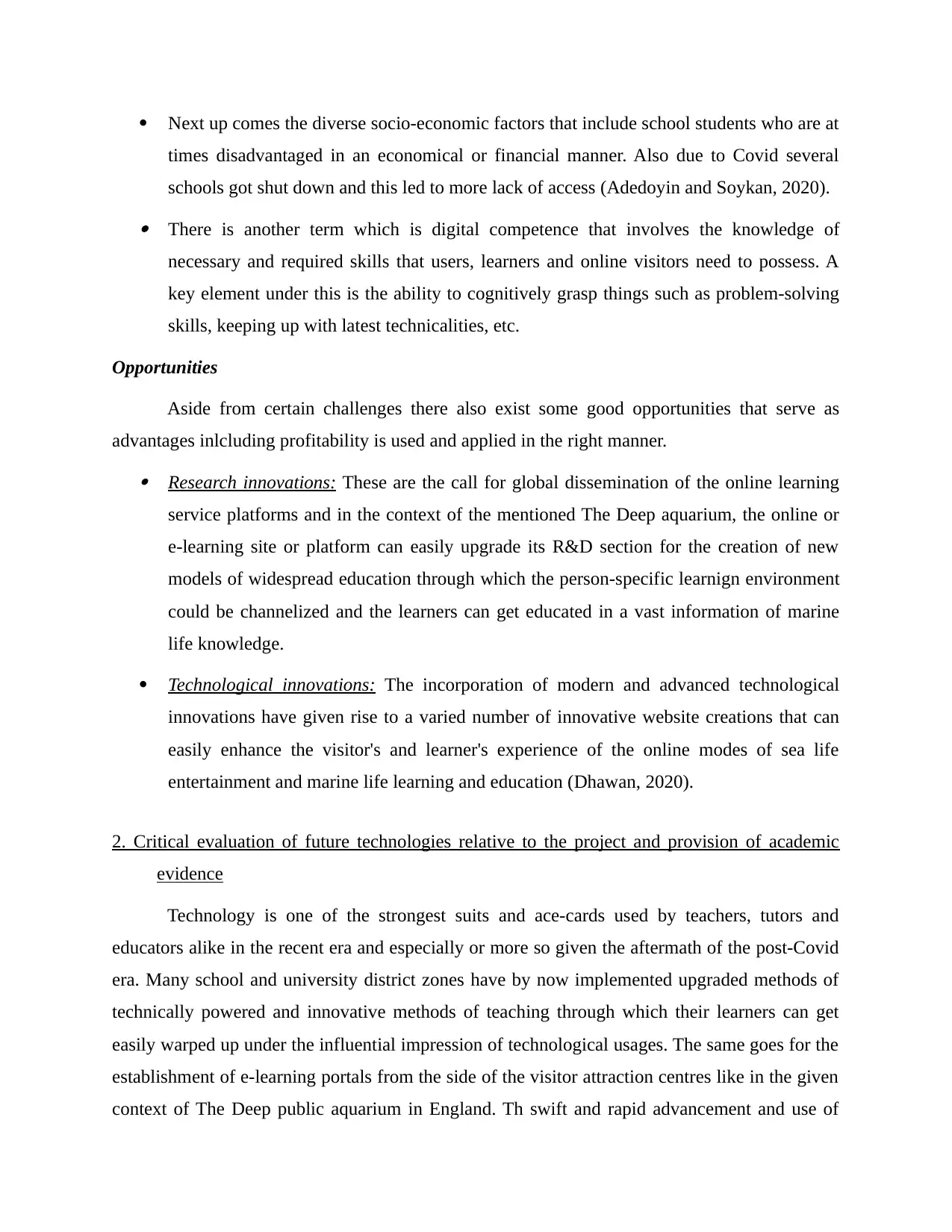
Next up comes the diverse socio-economic factors that include school students who are at
times disadvantaged in an economical or financial manner. Also due to Covid several
schools got shut down and this led to more lack of access (Adedoyin and Soykan, 2020). There is another term which is digital competence that involves the knowledge of
necessary and required skills that users, learners and online visitors need to possess. A
key element under this is the ability to cognitively grasp things such as problem-solving
skills, keeping up with latest technicalities, etc.
Opportunities
Aside from certain challenges there also exist some good opportunities that serve as
advantages inlcluding profitability is used and applied in the right manner. Research innovations: These are the call for global dissemination of the online learning
service platforms and in the context of the mentioned The Deep aquarium, the online or
e-learning site or platform can easily upgrade its R&D section for the creation of new
models of widespread education through which the person-specific learnign environment
could be channelized and the learners can get educated in a vast information of marine
life knowledge.
Technological innovations: The incorporation of modern and advanced technological
innovations have given rise to a varied number of innovative website creations that can
easily enhance the visitor's and learner's experience of the online modes of sea life
entertainment and marine life learning and education (Dhawan, 2020).
2. Critical evaluation of future technologies relative to the project and provision of academic
evidence
Technology is one of the strongest suits and ace-cards used by teachers, tutors and
educators alike in the recent era and especially or more so given the aftermath of the post-Covid
era. Many school and university district zones have by now implemented upgraded methods of
technically powered and innovative methods of teaching through which their learners can get
easily warped up under the influential impression of technological usages. The same goes for the
establishment of e-learning portals from the side of the visitor attraction centres like in the given
context of The Deep public aquarium in England. Th swift and rapid advancement and use of
times disadvantaged in an economical or financial manner. Also due to Covid several
schools got shut down and this led to more lack of access (Adedoyin and Soykan, 2020). There is another term which is digital competence that involves the knowledge of
necessary and required skills that users, learners and online visitors need to possess. A
key element under this is the ability to cognitively grasp things such as problem-solving
skills, keeping up with latest technicalities, etc.
Opportunities
Aside from certain challenges there also exist some good opportunities that serve as
advantages inlcluding profitability is used and applied in the right manner. Research innovations: These are the call for global dissemination of the online learning
service platforms and in the context of the mentioned The Deep aquarium, the online or
e-learning site or platform can easily upgrade its R&D section for the creation of new
models of widespread education through which the person-specific learnign environment
could be channelized and the learners can get educated in a vast information of marine
life knowledge.
Technological innovations: The incorporation of modern and advanced technological
innovations have given rise to a varied number of innovative website creations that can
easily enhance the visitor's and learner's experience of the online modes of sea life
entertainment and marine life learning and education (Dhawan, 2020).
2. Critical evaluation of future technologies relative to the project and provision of academic
evidence
Technology is one of the strongest suits and ace-cards used by teachers, tutors and
educators alike in the recent era and especially or more so given the aftermath of the post-Covid
era. Many school and university district zones have by now implemented upgraded methods of
technically powered and innovative methods of teaching through which their learners can get
easily warped up under the influential impression of technological usages. The same goes for the
establishment of e-learning portals from the side of the visitor attraction centres like in the given
context of The Deep public aquarium in England. Th swift and rapid advancement and use of
Paraphrase This Document
Need a fresh take? Get an instant paraphrase of this document with our AI Paraphraser
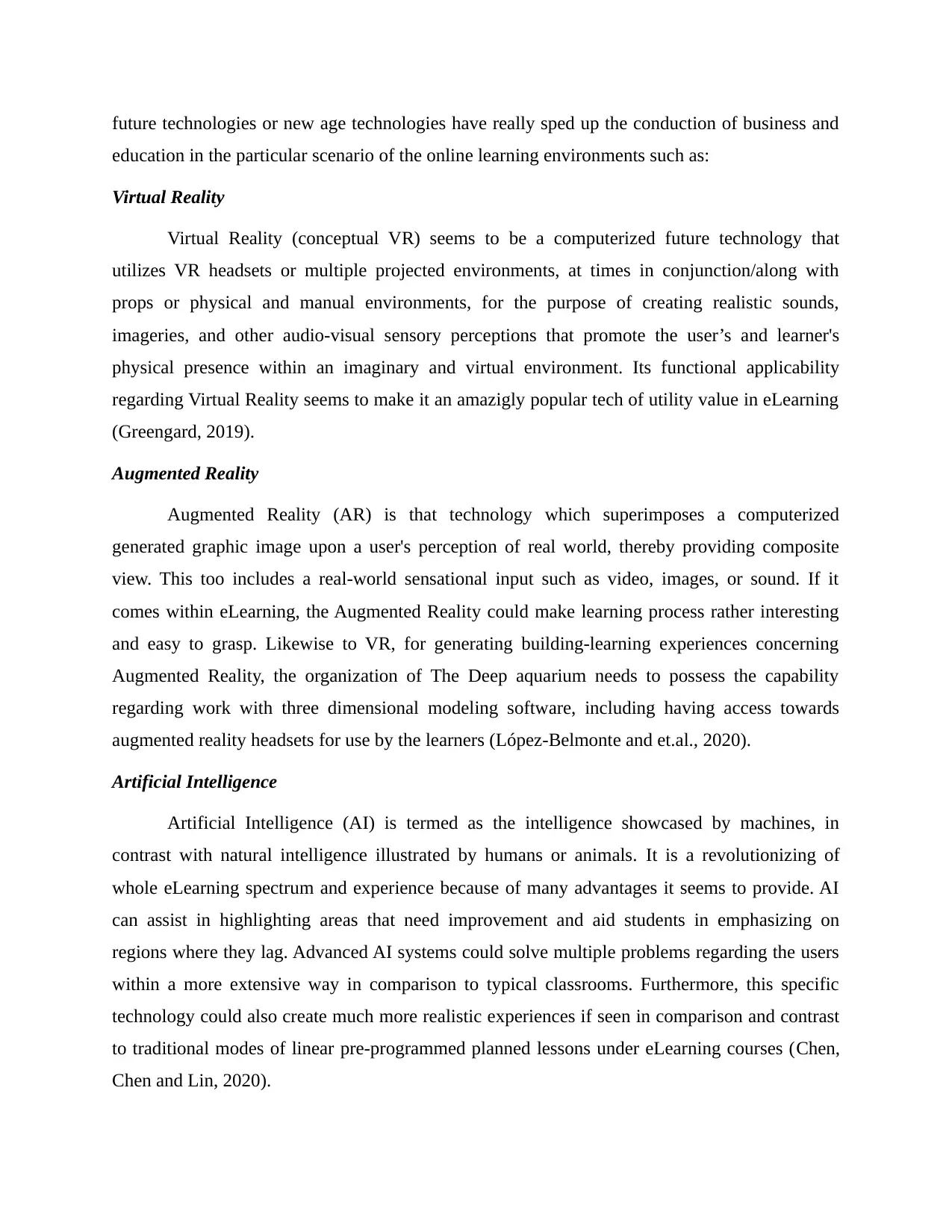
future technologies or new age technologies have really sped up the conduction of business and
education in the particular scenario of the online learning environments such as:
Virtual Reality
Virtual Reality (conceptual VR) seems to be a computerized future technology that
utilizes VR headsets or multiple projected environments, at times in conjunction/along with
props or physical and manual environments, for the purpose of creating realistic sounds,
imageries, and other audio-visual sensory perceptions that promote the user’s and learner's
physical presence within an imaginary and virtual environment. Its functional applicability
regarding Virtual Reality seems to make it an amazigly popular tech of utility value in eLearning
(Greengard, 2019).
Augmented Reality
Augmented Reality (AR) is that technology which superimposes a computerized
generated graphic image upon a user's perception of real world, thereby providing composite
view. This too includes a real-world sensational input such as video, images, or sound. If it
comes within eLearning, the Augmented Reality could make learning process rather interesting
and easy to grasp. Likewise to VR, for generating building-learning experiences concerning
Augmented Reality, the organization of The Deep aquarium needs to possess the capability
regarding work with three dimensional modeling software, including having access towards
augmented reality headsets for use by the learners (López-Belmonte and et.al., 2020).
Artificial Intelligence
Artificial Intelligence (AI) is termed as the intelligence showcased by machines, in
contrast with natural intelligence illustrated by humans or animals. It is a revolutionizing of
whole eLearning spectrum and experience because of many advantages it seems to provide. AI
can assist in highlighting areas that need improvement and aid students in emphasizing on
regions where they lag. Advanced AI systems could solve multiple problems regarding the users
within a more extensive way in comparison to typical classrooms. Furthermore, this specific
technology could also create much more realistic experiences if seen in comparison and contrast
to traditional modes of linear pre-programmed planned lessons under eLearning courses (Chen,
Chen and Lin, 2020).
education in the particular scenario of the online learning environments such as:
Virtual Reality
Virtual Reality (conceptual VR) seems to be a computerized future technology that
utilizes VR headsets or multiple projected environments, at times in conjunction/along with
props or physical and manual environments, for the purpose of creating realistic sounds,
imageries, and other audio-visual sensory perceptions that promote the user’s and learner's
physical presence within an imaginary and virtual environment. Its functional applicability
regarding Virtual Reality seems to make it an amazigly popular tech of utility value in eLearning
(Greengard, 2019).
Augmented Reality
Augmented Reality (AR) is that technology which superimposes a computerized
generated graphic image upon a user's perception of real world, thereby providing composite
view. This too includes a real-world sensational input such as video, images, or sound. If it
comes within eLearning, the Augmented Reality could make learning process rather interesting
and easy to grasp. Likewise to VR, for generating building-learning experiences concerning
Augmented Reality, the organization of The Deep aquarium needs to possess the capability
regarding work with three dimensional modeling software, including having access towards
augmented reality headsets for use by the learners (López-Belmonte and et.al., 2020).
Artificial Intelligence
Artificial Intelligence (AI) is termed as the intelligence showcased by machines, in
contrast with natural intelligence illustrated by humans or animals. It is a revolutionizing of
whole eLearning spectrum and experience because of many advantages it seems to provide. AI
can assist in highlighting areas that need improvement and aid students in emphasizing on
regions where they lag. Advanced AI systems could solve multiple problems regarding the users
within a more extensive way in comparison to typical classrooms. Furthermore, this specific
technology could also create much more realistic experiences if seen in comparison and contrast
to traditional modes of linear pre-programmed planned lessons under eLearning courses (Chen,
Chen and Lin, 2020).
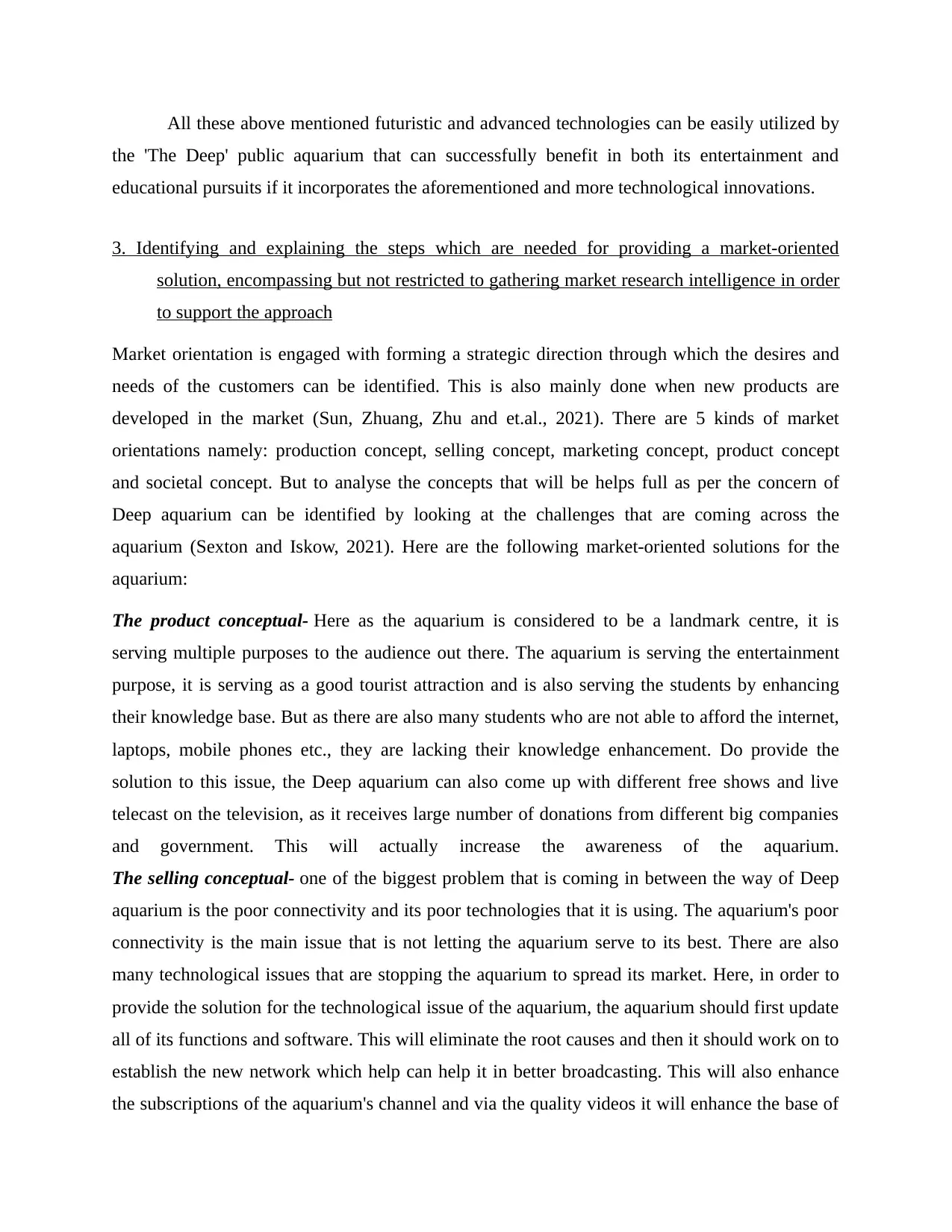
All these above mentioned futuristic and advanced technologies can be easily utilized by
the 'The Deep' public aquarium that can successfully benefit in both its entertainment and
educational pursuits if it incorporates the aforementioned and more technological innovations.
3. Identifying and explaining the steps which are needed for providing a market-oriented
solution, encompassing but not restricted to gathering market research intelligence in order
to support the approach
Market orientation is engaged with forming a strategic direction through which the desires and
needs of the customers can be identified. This is also mainly done when new products are
developed in the market (Sun, Zhuang, Zhu and et.al., 2021). There are 5 kinds of market
orientations namely: production concept, selling concept, marketing concept, product concept
and societal concept. But to analyse the concepts that will be helps full as per the concern of
Deep aquarium can be identified by looking at the challenges that are coming across the
aquarium (Sexton and Iskow, 2021). Here are the following market-oriented solutions for the
aquarium:
The product conceptual- Here as the aquarium is considered to be a landmark centre, it is
serving multiple purposes to the audience out there. The aquarium is serving the entertainment
purpose, it is serving as a good tourist attraction and is also serving the students by enhancing
their knowledge base. But as there are also many students who are not able to afford the internet,
laptops, mobile phones etc., they are lacking their knowledge enhancement. Do provide the
solution to this issue, the Deep aquarium can also come up with different free shows and live
telecast on the television, as it receives large number of donations from different big companies
and government. This will actually increase the awareness of the aquarium.
The selling conceptual- one of the biggest problem that is coming in between the way of Deep
aquarium is the poor connectivity and its poor technologies that it is using. The aquarium's poor
connectivity is the main issue that is not letting the aquarium serve to its best. There are also
many technological issues that are stopping the aquarium to spread its market. Here, in order to
provide the solution for the technological issue of the aquarium, the aquarium should first update
all of its functions and software. This will eliminate the root causes and then it should work on to
establish the new network which help can help it in better broadcasting. This will also enhance
the subscriptions of the aquarium's channel and via the quality videos it will enhance the base of
the 'The Deep' public aquarium that can successfully benefit in both its entertainment and
educational pursuits if it incorporates the aforementioned and more technological innovations.
3. Identifying and explaining the steps which are needed for providing a market-oriented
solution, encompassing but not restricted to gathering market research intelligence in order
to support the approach
Market orientation is engaged with forming a strategic direction through which the desires and
needs of the customers can be identified. This is also mainly done when new products are
developed in the market (Sun, Zhuang, Zhu and et.al., 2021). There are 5 kinds of market
orientations namely: production concept, selling concept, marketing concept, product concept
and societal concept. But to analyse the concepts that will be helps full as per the concern of
Deep aquarium can be identified by looking at the challenges that are coming across the
aquarium (Sexton and Iskow, 2021). Here are the following market-oriented solutions for the
aquarium:
The product conceptual- Here as the aquarium is considered to be a landmark centre, it is
serving multiple purposes to the audience out there. The aquarium is serving the entertainment
purpose, it is serving as a good tourist attraction and is also serving the students by enhancing
their knowledge base. But as there are also many students who are not able to afford the internet,
laptops, mobile phones etc., they are lacking their knowledge enhancement. Do provide the
solution to this issue, the Deep aquarium can also come up with different free shows and live
telecast on the television, as it receives large number of donations from different big companies
and government. This will actually increase the awareness of the aquarium.
The selling conceptual- one of the biggest problem that is coming in between the way of Deep
aquarium is the poor connectivity and its poor technologies that it is using. The aquarium's poor
connectivity is the main issue that is not letting the aquarium serve to its best. There are also
many technological issues that are stopping the aquarium to spread its market. Here, in order to
provide the solution for the technological issue of the aquarium, the aquarium should first update
all of its functions and software. This will eliminate the root causes and then it should work on to
establish the new network which help can help it in better broadcasting. This will also enhance
the subscriptions of the aquarium's channel and via the quality videos it will enhance the base of
⊘ This is a preview!⊘
Do you want full access?
Subscribe today to unlock all pages.

Trusted by 1+ million students worldwide
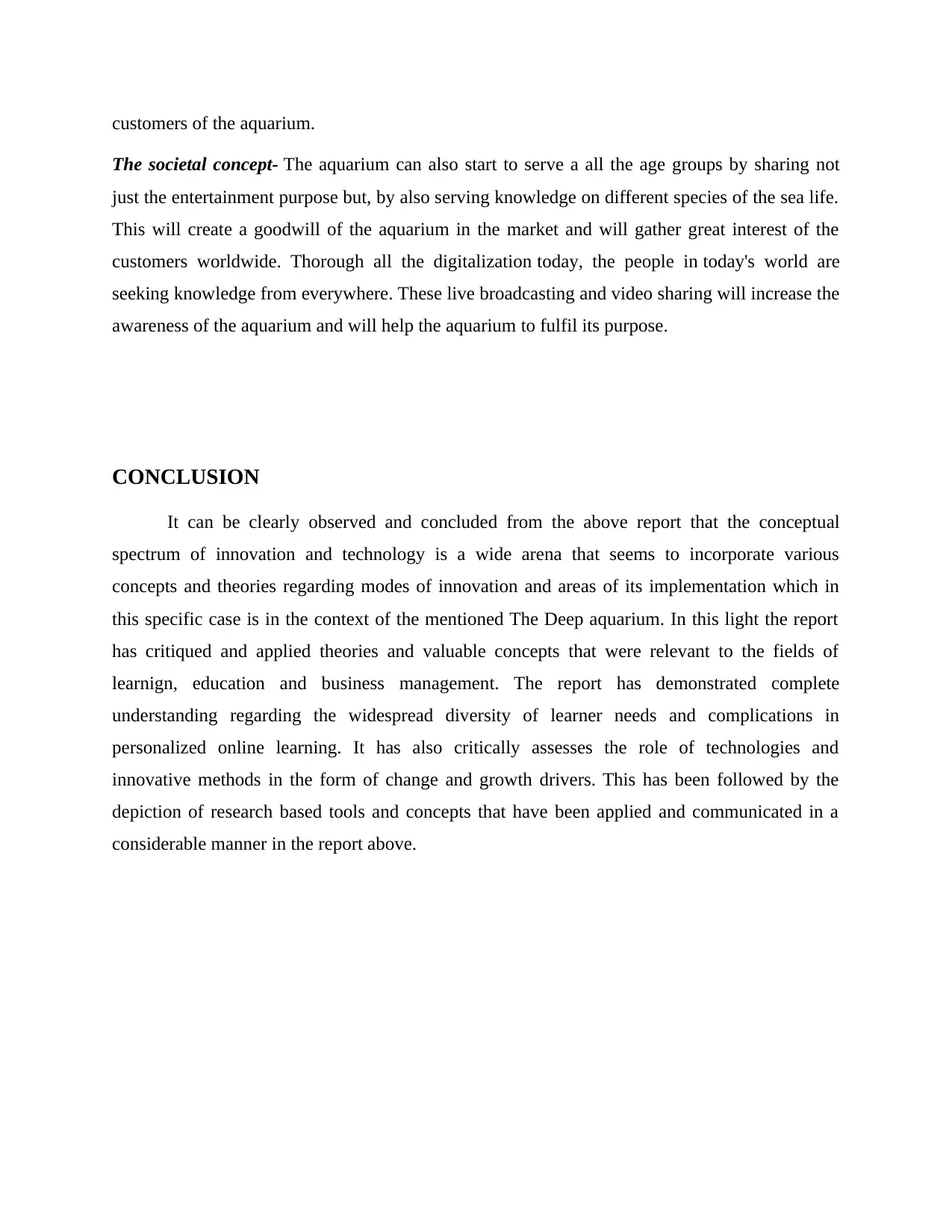
customers of the aquarium.
The societal concept- The aquarium can also start to serve a all the age groups by sharing not
just the entertainment purpose but, by also serving knowledge on different species of the sea life.
This will create a goodwill of the aquarium in the market and will gather great interest of the
customers worldwide. Thorough all the digitalization today, the people in today's world are
seeking knowledge from everywhere. These live broadcasting and video sharing will increase the
awareness of the aquarium and will help the aquarium to fulfil its purpose.
CONCLUSION
It can be clearly observed and concluded from the above report that the conceptual
spectrum of innovation and technology is a wide arena that seems to incorporate various
concepts and theories regarding modes of innovation and areas of its implementation which in
this specific case is in the context of the mentioned The Deep aquarium. In this light the report
has critiqued and applied theories and valuable concepts that were relevant to the fields of
learnign, education and business management. The report has demonstrated complete
understanding regarding the widespread diversity of learner needs and complications in
personalized online learning. It has also critically assesses the role of technologies and
innovative methods in the form of change and growth drivers. This has been followed by the
depiction of research based tools and concepts that have been applied and communicated in a
considerable manner in the report above.
The societal concept- The aquarium can also start to serve a all the age groups by sharing not
just the entertainment purpose but, by also serving knowledge on different species of the sea life.
This will create a goodwill of the aquarium in the market and will gather great interest of the
customers worldwide. Thorough all the digitalization today, the people in today's world are
seeking knowledge from everywhere. These live broadcasting and video sharing will increase the
awareness of the aquarium and will help the aquarium to fulfil its purpose.
CONCLUSION
It can be clearly observed and concluded from the above report that the conceptual
spectrum of innovation and technology is a wide arena that seems to incorporate various
concepts and theories regarding modes of innovation and areas of its implementation which in
this specific case is in the context of the mentioned The Deep aquarium. In this light the report
has critiqued and applied theories and valuable concepts that were relevant to the fields of
learnign, education and business management. The report has demonstrated complete
understanding regarding the widespread diversity of learner needs and complications in
personalized online learning. It has also critically assesses the role of technologies and
innovative methods in the form of change and growth drivers. This has been followed by the
depiction of research based tools and concepts that have been applied and communicated in a
considerable manner in the report above.
Paraphrase This Document
Need a fresh take? Get an instant paraphrase of this document with our AI Paraphraser
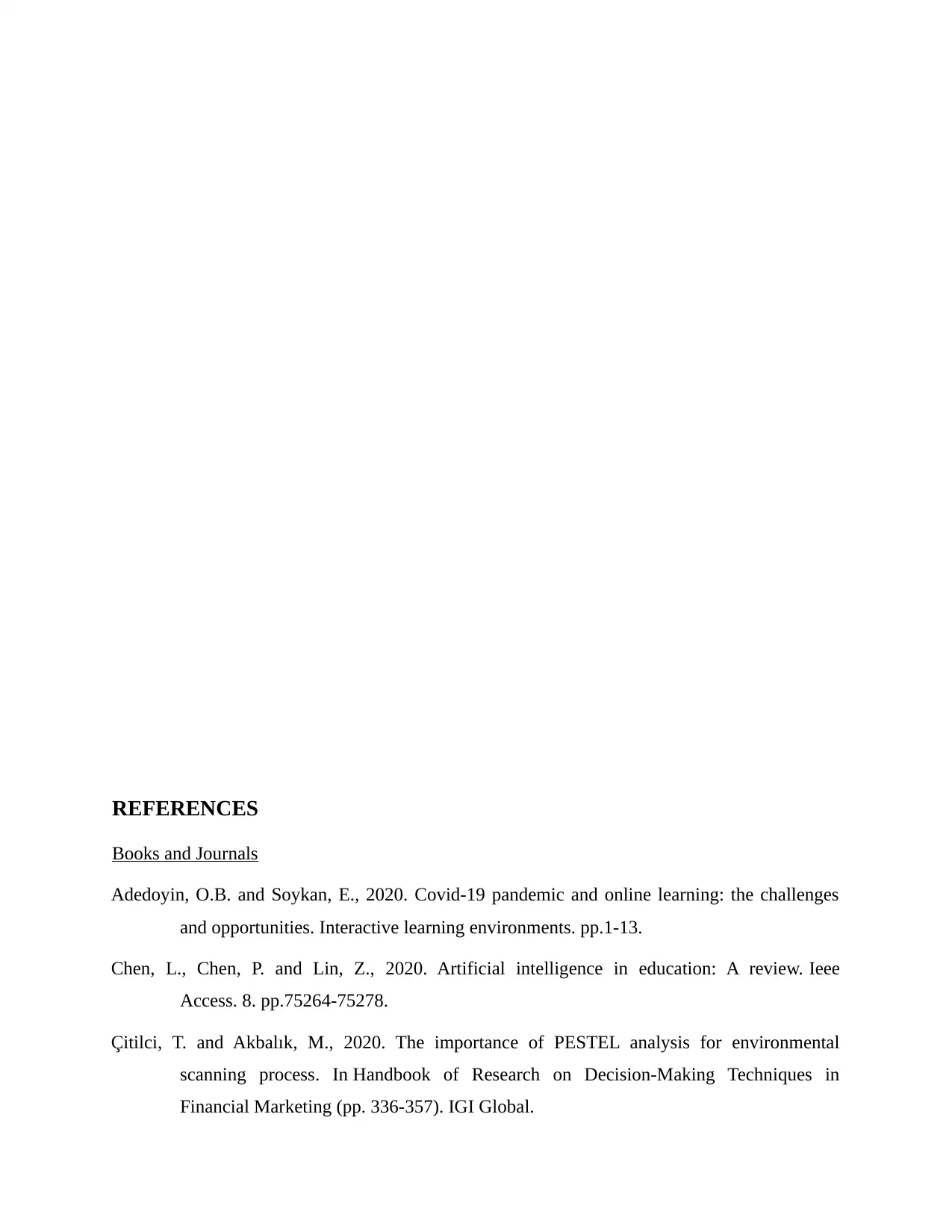
REFERENCES
Books and Journals
Adedoyin, O.B. and Soykan, E., 2020. Covid-19 pandemic and online learning: the challenges
and opportunities. Interactive learning environments. pp.1-13.
Chen, L., Chen, P. and Lin, Z., 2020. Artificial intelligence in education: A review. Ieee
Access. 8. pp.75264-75278.
Çitilci, T. and Akbalık, M., 2020. The importance of PESTEL analysis for environmental
scanning process. In Handbook of Research on Decision-Making Techniques in
Financial Marketing (pp. 336-357). IGI Global.
Books and Journals
Adedoyin, O.B. and Soykan, E., 2020. Covid-19 pandemic and online learning: the challenges
and opportunities. Interactive learning environments. pp.1-13.
Chen, L., Chen, P. and Lin, Z., 2020. Artificial intelligence in education: A review. Ieee
Access. 8. pp.75264-75278.
Çitilci, T. and Akbalık, M., 2020. The importance of PESTEL analysis for environmental
scanning process. In Handbook of Research on Decision-Making Techniques in
Financial Marketing (pp. 336-357). IGI Global.
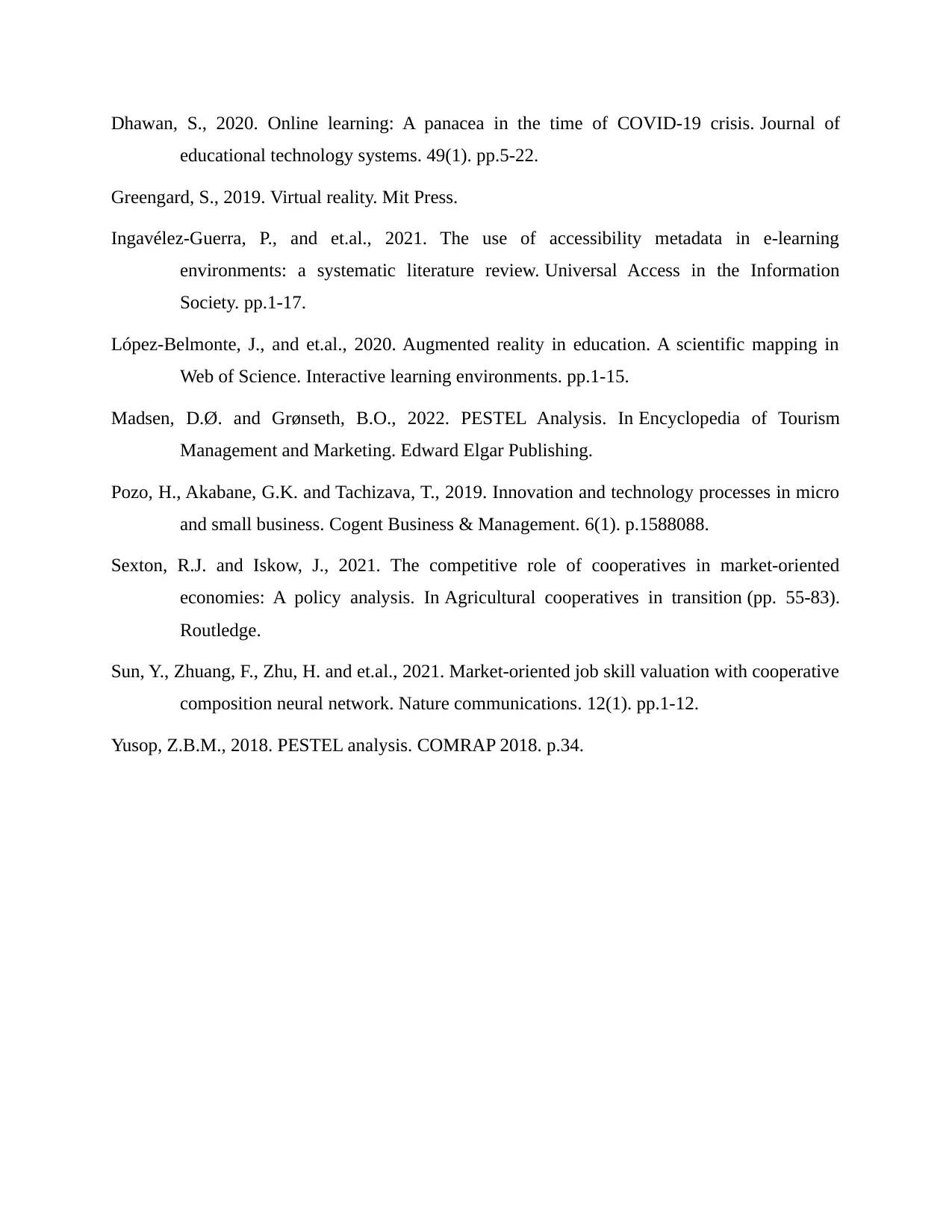
Dhawan, S., 2020. Online learning: A panacea in the time of COVID-19 crisis. Journal of
educational technology systems. 49(1). pp.5-22.
Greengard, S., 2019. Virtual reality. Mit Press.
Ingavélez-Guerra, P., and et.al., 2021. The use of accessibility metadata in e-learning
environments: a systematic literature review. Universal Access in the Information
Society. pp.1-17.
López-Belmonte, J., and et.al., 2020. Augmented reality in education. A scientific mapping in
Web of Science. Interactive learning environments. pp.1-15.
Madsen, D.Ø. and Grønseth, B.O., 2022. PESTEL Analysis. In Encyclopedia of Tourism
Management and Marketing. Edward Elgar Publishing.
Pozo, H., Akabane, G.K. and Tachizava, T., 2019. Innovation and technology processes in micro
and small business. Cogent Business & Management. 6(1). p.1588088.
Sexton, R.J. and Iskow, J., 2021. The competitive role of cooperatives in market-oriented
economies: A policy analysis. In Agricultural cooperatives in transition (pp. 55-83).
Routledge.
Sun, Y., Zhuang, F., Zhu, H. and et.al., 2021. Market-oriented job skill valuation with cooperative
composition neural network. Nature communications. 12(1). pp.1-12.
Yusop, Z.B.M., 2018. PESTEL analysis. COMRAP 2018. p.34.
educational technology systems. 49(1). pp.5-22.
Greengard, S., 2019. Virtual reality. Mit Press.
Ingavélez-Guerra, P., and et.al., 2021. The use of accessibility metadata in e-learning
environments: a systematic literature review. Universal Access in the Information
Society. pp.1-17.
López-Belmonte, J., and et.al., 2020. Augmented reality in education. A scientific mapping in
Web of Science. Interactive learning environments. pp.1-15.
Madsen, D.Ø. and Grønseth, B.O., 2022. PESTEL Analysis. In Encyclopedia of Tourism
Management and Marketing. Edward Elgar Publishing.
Pozo, H., Akabane, G.K. and Tachizava, T., 2019. Innovation and technology processes in micro
and small business. Cogent Business & Management. 6(1). p.1588088.
Sexton, R.J. and Iskow, J., 2021. The competitive role of cooperatives in market-oriented
economies: A policy analysis. In Agricultural cooperatives in transition (pp. 55-83).
Routledge.
Sun, Y., Zhuang, F., Zhu, H. and et.al., 2021. Market-oriented job skill valuation with cooperative
composition neural network. Nature communications. 12(1). pp.1-12.
Yusop, Z.B.M., 2018. PESTEL analysis. COMRAP 2018. p.34.
⊘ This is a preview!⊘
Do you want full access?
Subscribe today to unlock all pages.

Trusted by 1+ million students worldwide
1 out of 13
Related Documents
Your All-in-One AI-Powered Toolkit for Academic Success.
+13062052269
info@desklib.com
Available 24*7 on WhatsApp / Email
![[object Object]](/_next/static/media/star-bottom.7253800d.svg)
Unlock your academic potential
Copyright © 2020–2025 A2Z Services. All Rights Reserved. Developed and managed by ZUCOL.



